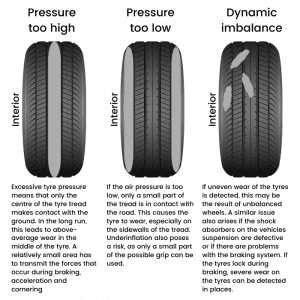When did you last check your tyres? Whether you’re a grey fleet driver or a company car driver, you have a responsibility to check your vehicle is roadworthy, not only for the safety of yourself and the public but also to avoid up to 3 penalty points and a fine of up to £2,500 per tyre.
Checking your tyres takes just a matter of minutes and employers should encourage their drivers to perform these checks regularly.
Your tyres are the only part of your vehicle that are in contact with the road and the condition of your tyres is key to your safety. Because they play such a vital role, there are 2 specific requirements for legal tyres.
Here’s everything you need to know about tyres and driving
- Tyres must be fit for purpose and be free from any defects which might damage the road or endanger any person.
To be ‘fit for purpose’, tyres must not have:
Any lumps, bumps or bulges, as these can mean structural damage.
A cut or tear bigger than 25mm or 10% of the width of the tyre, whichever is greater, and which is deep enough to reach the ply or cord.
Any part of the ply or cord exposed.
- Tyres must be inflated to the right pressure.
That means sticking to the pressure recommended by both your vehicle manufacture and the tyre manufacturer.
What if I get into an accident with illegal or dangerous tyres?
If you’re involved in an accident and your tyres don’t meet the legal minimum standards, any insurance claim you make could be invalidated.
If you drive with tyres that are dangerous because they’re worn or bald, you could be prosecuted for using a vehicle in a dangerous condition.
It could get you a fine of up to £2,500 and 3 points on your licence – that’s per tyre. If all 4 tyres are found to be dangerous, you could be looking at a £10,000 fine and 12 points.
What should my tyre pressure be?
Tyre pressure isn’t ‘one size fits all.’ Each car will have its own recommended pressures. You can find these inside the driver’s door, inside your petrol cap or in the owner’s manual.
Your vehicle will fail its MOT if the tyres have any of these faults or if you have tyres of different sizes on the same axle.
What is the legal tyre tread depth?
The legal minimum tyre tread depth varies by each type of vehicle.
| Type of vehicle | Minimum tread depth |
| Cars Goods vehicles (<3,500kg) Trailers and caravans (<3,500kg) |
At least 1.6mm throughout a continuous band in the centre 3/4 of the tread and around the entire circumference of the tyre. |
| Most larger vehicles | At least 1.0mm throughout a continuous band across at least 3/4 of the breadth of the tread and around the entire circumference. The original tread pattern must be visible in the remaining quarter. |
| Motorcycles 50cc and over | At least 1.0mm throughout a continuous band across at least 3/4 of the breadth of the tread and around the entire circumference. The original tread pattern must be visible in the remaining quarter. |
| Mopeds and motorcycles under 50cc | The original tread pattern must be visible. |
What causes tyre wear?
Tyres will start to wear out over time, but some factors can increase the wear.
Driving style – Aggressive cornering and braking increases wear.
Position – The tyres on the driven wheels will wear more quickly and even more so on front wheel drive cars as these handle the steering too.
Speed – High speed driving increases temperature and wear.
Load – Excess load increases wear, as does vehicle weight. Tyres on heavier cars will wear faster.
Pressure – Under inflation (through increased flexing and temperature) and over inflation (through reduced contact area) can both increase wear.
Alignment – Tyres will wear quickly and unevenly if wheel alignment is wrong of if suspension components like shock absorbers are worn.
Dangers of driving with a low tyre tread.
Driving on tyres with tread below the legal limit can be incredibly dangerous, as well as illegal. It’s even worse driving with bald tyres where the tread has worn away altogether.
Hazards of driving with worn tyres include:
Less grip on wet roads.
Longer stopping distances.
A greater risk of aquaplaning.
Less traction on icy roads or snow.
More chance of punctures, which can lead to a sudden blowout.
If you change your tyres when the tread wears down, you’ll have better grip on the roads and less stopping distance.
Worn tyres or flat spots may also cause your steering wheel to shake or vibrate.
Contact sales@drivercheck.co.uk to ensure your Grey Fleet vehicles are fully compliant and to learn more about our Grey Fleet service.

